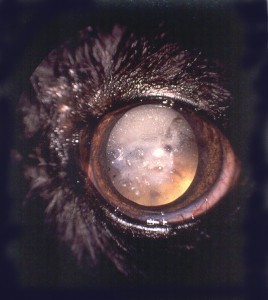
Cataracts are the most common eye disease in Australian Shepherds. They can occur for reasons other than heredity (other diseases, injury, or nutritional imbalance) but these other causes are not common and should not be assumed to be the reason. If in doubt, consult a veterinary ophthalmologist.
Hereditary cataracts are bilateral, meaning they occur in both eyes, but they may not appear at the same time. If a cataract is noted on one eye, it is wise to recheck in six months to a year to see if one develops in the other. Hereditary cataracts progress starting as small opacities and advancing, sometimes to the point of clouding the entire lens. Dogs with these generalized cataracts are unable to distinguish anything but extremes of light and dark. Cataracts do not cause the dog any pain and usually progress slowly enough that the dog adjusts to its vision loss. In Aussies cataracts almost never occur in young puppies. Affected dogs most commonly present signs as mature adults, though cataracts may start in early adulthood or not until old age. This wide range in onset has made the disease extremely difficult to predict or eliminate; affected dogs are often bred before the owner realizes they will develop the disease.
Cataracts are classified by where in the lens they first develop. The lens is round when viewed from the front or back, thickest in the middle and tapering to the outer edge. The front is referred to as the anterior; the back is the posterior. The inside is the nucleus; the outside, the cortex, and the outer (round) edge, the equator. The center of the lens is the polar area. So, if a dog has posterior polar cortical cataracts, they are forming on the back side in the center on the outer layer. This is where the majority of Aussie cataracts start.
The mode of inheritance for most Aussie cataracts is dominant with incomplete penetrance, meaning not every dog with the mutation will develop cataracts. It is also extremely variable in the age of presentation. It is possible that some dogs that ultimately are or would have been affected are not detected because they die first or the owner stops doing eye exams before the cataracts develop.
The release of a DNA test for one form of hereditary cataracts in early 2008 should help reduce the frequency of cataracts in the breed. This mutation, in a gene called HSF4, is associated with 70% of the inherited cataracts in Australian Shepherds. (At this point we do not know what genes cause the remainder.) It is a risk factor – not every dog with the mutation gets cataracts. The mutation is dominant, so dogs with even one copy are at risk of developing cataracts at some point in their lives. Dogs with the mutation who remain healthy will pass the mutation to their offspring, who will also be at risk for cataracts. This mutation is extremely common in the breed: Approximately one in four Aussies has it. Because it is so common, eliminating all of them from breeding is not an option.
Because the HSF4 mutation is only a risk factor and because there are hereditary cataracts that are not caused by HSF4, all breeding stock should receive annual exams by a veterinary ophthalmologist.
Breeding advice:
– Dogs with cataracts should not be bred.
– Dogs with one copy of the HSF4 mutation should be bred only to clear-tested dogs.
– If a dog has two copies of the HSF4 mutation it would be better to use a clear or single-mutation full sibling of equal quality for breeding. If a two-mutation dog is bred, it should only be to a clear-tested mate.
– First-step relatives (parents, offspring, full and half siblings) of an HSFS4-clear dog diagnosed with hereditary cataracts should be bred only to HSF4-clear mates who have no family history of non-HSF4 cataracts.
